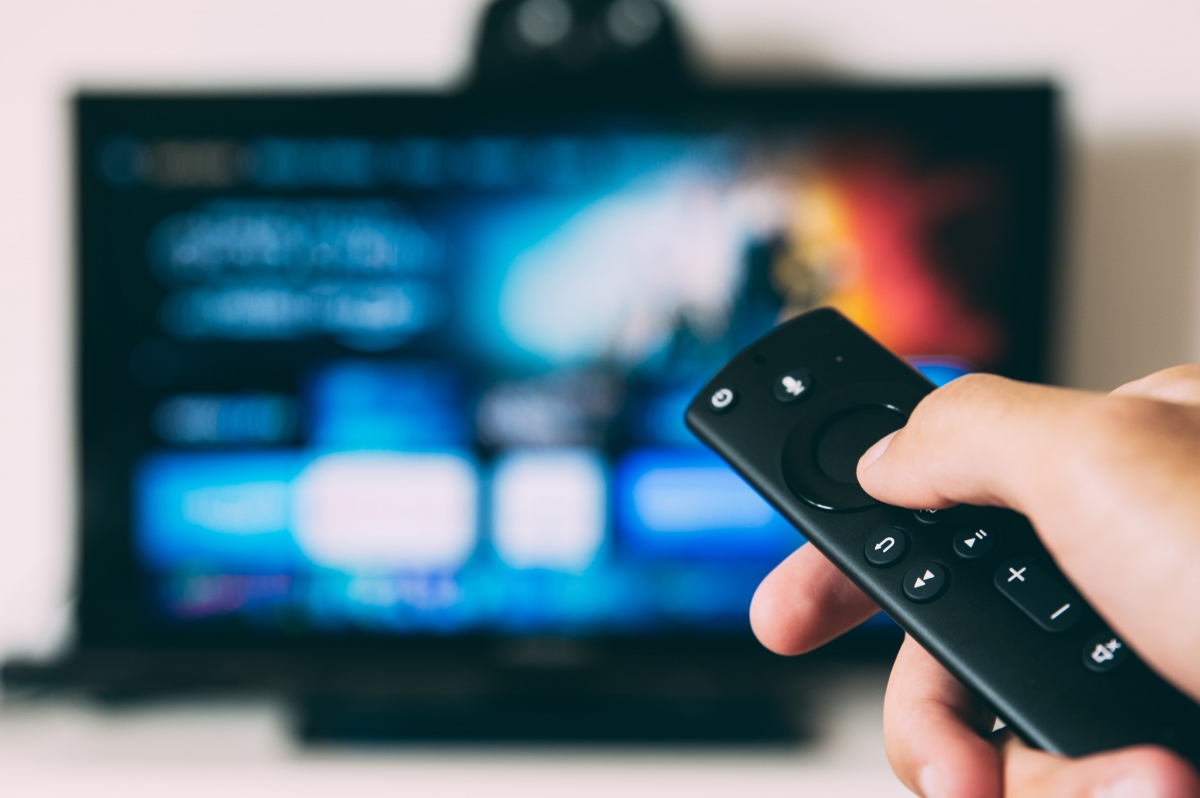That's cringe! – Wait a minute. What is cringe?
The word “cringe” is on everyone's lips. What does it mean? How can it be described? An attempt to explain the phenomenon using established psychological constructs.
Note: This article was already reviewed and is published in the German version of In-Mind.
 Picture 1. The diverse media content we are exposed to also increases the likelihood of coming across cringe videos
Picture 1. The diverse media content we are exposed to also increases the likelihood of coming across cringe videos
In recent years, numerous “cringe compilations” or other videos with the phrase “Try not to cringe” in the title have received millions of views on YouTube. “Cringe” has become a popular term – for example, among Internet users talking about bad commercials [1] or young people discussing social media content [2].
So, what exactly is cringe? The Urban Dictionary, an online dictionary of slang words, describes cringe as a feeling of embarrassment experienced in response to an embarrassing person. A subreddit dedicated to cringe content is called “When it hurts to watch.” Imagine watching a cringe video and observing one's own reactions. A clip from the dating show Love at First Kiss is a good example. In this dating show, two singles are expected to kiss each other at their first-ever meeting. The encounter between Josh and Emily has gone viral (over twelve million clicks on YouTube; to be found under Cringe at First Kiss | Love at First Kiss or here). Josh is very confident before the encounter. However, the planned kiss turns into a bizarre embrace that lasts far too long and is irritating, awkward, and embarrassing for Emily – and the viewers. The lay definitions seem to make perfect sense: one (the viewer) is uncomfortable with the (mis-)behavior (the awkward hug) of the person (Josh) in the cringe video.
The lay definitions, combined with one's reaction to cringe content, provide some valuable clues to understand the basic constellation of cringe better: There is a person experiencing emotions; there is another person behaving in a certain way to whom those emotions are related; and finally, an emotion is evoked in the former because of the specific behavior of the latter. The phenomenon of cringe can be approached from this starting point, using established psychological constructs and previously researched emotions.
So what kind of emotion is behind cringe? Cringe is a mixed emotion. Such emotions describe the simultaneous occurrence of emotions of different valence. For example, after watching the movie Life is Beautiful, some people feel sad and happy at the same time [3]. In terms of cringe, this means that people feel a positive emotion (which should explain the high popularity of cringe videos) and a negative emotion at the same time. In this article, we will mostly focus on the negative emotions behind cringe.
Do feelings of guilt and shame cause cringe?
The negative emotions we experience in response to a cringe behavior arguably include guilt and shame. With guilt, a person evaluates themselves very negatively (“I am a bad person”) because of a specific behavior of their own that has hurt someone else (e.g., because they have committed an assault). This person feels guilty and is then motivated to make amends for this behavior (e.g., through first aid, confession, apology). Guilt can occur within a person without anyone else knowing about the wrongdoing. Shame, on the other hand, occurs only when there are witnesses to morally wrong behavior or when one disappoints the members of one's group. Here, the person evaluates themselves negatively based on their entire self, sees themselves as worthless, and feels the need to hide [4].
At this point, it is important to note that guilt and shame are so-called self-conscious emotions. These are emotions that are primarily felt about oneself or one's actions. For example, someone is proud of their achievement [5]. Alternatively, someone may feel ashamed of their misbehavior. However, this self-reference is not present in all (negative) emotions. For example, people experience fear in response to external threats. Fear, therefore, refers to something other than the self. But to what extent can self-related emotions such as guilt and shame help us understand the phenomenon of cringe? After all, cringe videos show the behavior of other people to which one reacts negatively. So one feels something – but not because of oneself, but because of another person.
 Picture 2. If it gets too cringe, it becomes unpleasant to continue watching
Picture 2. If it gets too cringe, it becomes unpleasant to continue watching
The importance of vicarious emotions
If one can perceive emotions in one’s counterpart, one can also vicariously feel those emotions for that counterpart. This is referred to as vicarious emotion [6]. Guilt and shame, for example, can be felt not only for one’s own actions, but also for those of another person – without one being responsible for those actions. One can feel vicarious guilt or vicarious shame by empathically putting oneself in the other person's shoes (so-called empathic shame/ guilt). Also, one can feel vicarious guilt or vicarious shame because the wrongdoer belongs to one's group. Imagine being related to someone who has committed an assault, and then feeling guilty for that person on behalf of your whole family. This emotion can punish the wrongdoer, which can uphold or restore the norms within the group [7].
From vicarious emotions to embarrassment
Are vicarious guilt and vicarious shame appropriate for describing the emotional processes of the cringe experience? There is at least one central argument against this: Guilt and shame are usually severe and long-lasting reactions to serious wrongdoing. Such wrongdoing might include physical harm or betraying friends – but not an embarrassing video of someone making a fool of themselves. Embarrassment seems to be a more appropriate explanation: It is a negative emotion in response to misbehavior or a violation of norms, but the misdeed and the emotional intensity are less severe. Embarrassment is not so much a painful emotion as an unpleasant one [5]. It is a self-related, unpleasant emotional response to the violation of expectations or social norms [8]. It is not caused by a serious, but rather a trivial, morally unimportant, and short-term moral wrongdoing [4] and occurs when a person realizes that their self-image does not match the image others have of them [5].
Such a mismatch can occur when one loses control, does not behave appropriately towards others, or is overly praised [4]. Embarrassment requires witnesses [5]. They can be real people (e.g., the people who observe you in the embarrassing situation) or imagined (e.g., one notices something embarrassing about oneself alone – such as a tear in one’s trousers – and wonders what others would think if they saw it; see also [9]).
Typical reactions to embarrassment are blushing, nervous laughter, and avoiding eye contact. These are signals from the misbehaving person (the perpetrator) to the witnesses of the embarrassing event. These signals indicate to the witnesses that the misbehaving person is aware of the embarrassing situation and regrets or is embarrassed by it. In this way, the witnesses of the embarrassment see that the perpetrator is aware of the embarrassment and otherwise still respects the usual norms [10], that is, that this embarrassing situation happened just by accident and that the perpetrator usually respects the violated norms. As a result, witnesses of the embarrassment are more inclined to overlook the perpetrator's faux pas causing the embarrassment [11].
From perceived to vicarious embarrassment
In light of these characteristics, embarrassment is a promising candidate for explaining cringe. However, when watching cringe videos, people are not embarrassed by their own behavior, but by the behavior of others. Again, the concept of vicarious emotions seems helpful: Vicarious embarrassment is the embarrassment one feels when watching someone else doing something embarrassing [8].
In many cringe videos, the person causing the cringe moment is unaware of the vicarious embarrassment they are causing – for example, when someone records a video of themselves singing without realizing that they cannot sing. However, the video's viewers immediately notice the singer's lack of talent and, in the absence of any signs of embarrassment on the part of the singer, feel ashamed on the singer's behalf. This lack of awareness of one's potential to cause vicarious embarrassment in others seems essential – and at the same time marks a substantial difference from another emotion often felt when observing other people making fools of themselves (think of the talentless contestants in the preliminary rounds of a music casting show): Schadenfreude, i.e., the joy at the mishap and resulting harm to others [12]. Schadenfreude may be a meaningful description of the emotion felt towards candidates who fail in casting shows. However, schadenfreude does not help explain the emotion felt by viewers of cringe videos in which, for example a person sings very badly but otherwise suffers no mishap or harm.
 Picture 3. Whether confronted with cringey or simply embarrassing situations, sometimes the only thing that helps is to look away
Picture 3. Whether confronted with cringey or simply embarrassing situations, sometimes the only thing that helps is to look away
Vicarious embarrassment is a promising explanation for the phenomenon of cringe, but it may still be insufficient. Keep in mind that vicarious embarrassment is an unpleasant emotion. Then, the question arises as to why people – judging by the millions of clicks on some cringe content – seem to enjoy watching such videos. Why would anyone want to experience an unpleasant emotion over and over again? This question is not specific to cringe, but touches on other genres of aversive media content (e.g., horror, violent, or sad films). For example, research on the reception of violent films suggests that perceived violence (i.e., the aversive media content) in a movie trailer reduces interest in watching the entire film. However, this was not the case when the violence was perceived as meaningful, moving, or thought-provoking [13]. It is possible that media content that is perceived as embarrassing is still watched because interest in it depends on factors other than vicarious embarrassment. In other words, if vicarious embarrassment represents the negative pole of the mixed emotion cringe, there should also be a positive pole. It seems plausible that people would accept the threat of vicarious embarrassment in exchange for fun and entertainment.
Another consideration regarding aversive media content is that viewers are socially rewarded for watching such content, for example, because watching a violent movie together creates a shared experience [13]. Watching cringe videos could be understood in a similar way: A viewer watches a widely shared cringe video and is vicariously embarrassed, just as other viewers of that video may have been. The fact that the person feels similar emotions to the others, and thus shows that they are sensitive to the violation of norms portrayed (after all, this is what shaming others and, to some extent, cringe is about), means that the viewer sees themselves as a member of a community (in this case, the online community).
 Picture 4. Schadenfreude is when one takes pleasure in someone else's unfortunate situation
Picture 4. Schadenfreude is when one takes pleasure in someone else's unfortunate situation
It is also possible that by watching cringe content, a viewer is not only testing whether they know the norms of the community and react to their violation like the community, but also using the content to learn about those norms – in the sense of Social Learning Theory [14]. Therefore, someone would not only take away a strong experience of vicarious embarrassment from watching the aforementioned Love at First Kiss clip, but also a lesson in how a first romantic encounter should not be like.
Even if these assumptions may sound plausible based on established theories, they have yet to be tested empirically. Overall, there has been hardly any psychological research on the phenomenon of cringe. However, the thoughts compiled here make it clear why it might be worthwhile and fruitful not to dismiss cringe as a quirky phenomenon, but to consider it as a serious topic for psychological research.
Bibliography
[1] G. Gomez-Mejia, “‘Fail, Clickbait, cringe, cancel, woke’: Vernacular Criticisms of digital advertising in social media platforms,” in Social computing and social media. Participation, user experience, consumer experience, and applications of social computing. 12th International Conference, SCSM 2020, Copenhagen, July 19-24. 2020 Proceedings: Part II, Meiselwitz, Ed. Springer Nature, 2020, pp. 309–324. doi: 10.1007/978-3-030-49576-3.
[2] E. Carlquist, L. Prøitz, and K. Roen, “Streams of fun and cringe: talking about Snapchat as mediated affective practice,” Subjectivity, vol. 12, no. 3, pp. 228–246, Aug. 2019, doi: 10.1057/s41286-019-00074-9.
[3] J. T. Larsen and A. P. McGraw, “The case for mixed emotions,” Social and Personality Psychology Compass, vol. 8, no. 6, pp. 263–274, Jun. 2014, doi: 10.1111/spc3.12108.
[4] A. H. Buss, Self-consciousness and social anxiety. W. H. Freeman & Company, 1980.
[5] M. Lewis, “Self-conscious emotions. Embarrassment, pride, shame, guilt, and hubris.,” in Handbook of Emotions, 4th ed., L. F. Barrett, M. Lewis, and J. M. Haviland-Jones, Eds. Guilford Press, 2016, pp. 792–814.
[6] C. Keysers and V. Gazzola, “Expanding the mirror: vicarious activity for actions, emotions, and sensations,” Current Opinion in Neurobiology, vol. 19, no. 6, pp. 666–671, Dec. 2009, doi: 10.1016/j.conb.2009.10.006.
[7] S. C. M. Welten, M. Zeelenberg, and S. M. Breugelmans, “Vicarious shame,” Cognition & Emotion, vol. 26, no. 5, pp. 836–846, Aug. 2012, doi: 10.1080/02699931.2011.625400.
[8] A. Uysal, G. Akbaş, E. Helvacı, and İ. Metin, “Validation and correlates of the vicarious embarrassment scale,” Personality and Individual Differences, vol. 60, pp. 48–53, Apr. 2014, doi: 10.1016/j.paid.2013.12.015.
[9] A. V. Mayer, F. M. Paulus, and S. Krach, “A psychological perspective on vicarious embarrassment and shame in the context of cringe humor,” Humanities, vol. 10, no. 4, p. 110, Oct. 2021, Art no. e110, doi: 10.3390/h10040110.
[10] S. Krach, L. Müller-Pinzler, L. Rademacher, D. S. Stolz, and F. M. Paulus, “Neuronal pathways of embarrassment,” E-neuroforum, vol. 7, no. 2, pp. 37–42, May 2016, doi: 10.1007/s13295-016-0024-4.
[11] D. K. Marcus, “The Perception of ‘Live’ Embarrassment: A social relations analysis of class presentations,” Cognition & Emotion, vol. 13, no. 1, pp. 105–117, Jan. 1999, doi: 10.1080/026999399379393.
[12] F. M. Paulus, L. Müller-Pinzler, D. S. Stolz, A. V. Mayer, L. Rademacher, and S. Krach, “Laugh or cringe? Common and distinct processes of reward-based schadenfreude and empathy-based fremdscham,” Neuropsychologia, vol. 116, pp. 52–60, Jul. 2018, doi: 10.1016/j.neuropsychologia.2017.05.030.
[13] A. Bartsch and M. Mares, “Making sense of violence: perceived meaningfulness as a predictor of audience interest in violent media content,” Journal of Communication, vol. 64, no. 5, pp. 956–976, Sep. 2014, doi: 10.1111/jcom.12112.
[14] J. Dębiec and A. Olsson, “Social Fear Learning: from Animal Models to Human Function,” Trends in Cognitive Sciences, vol. 21, no. 7, pp. 546–555, Jul. 2017, doi: 10.1016/j.tics.2017.04.010.
Figures
Picture 1. Glenn Casrestens- Peters via unsplash.com
Picture 2. Cottonbro via pexels.com
Picture 3. Haley Murray via unsplash.com
Picture 4. Brooke Cagle via unsplash.com


